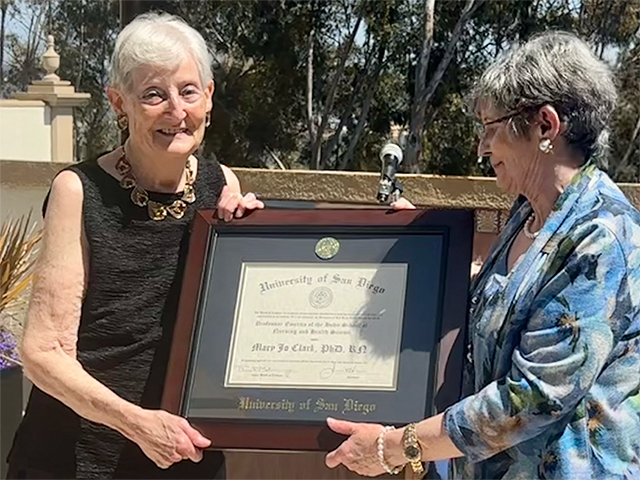Summer Scholars Showcase Research at Colloquium
The relaxing days of summer vacation are dwindling for all University of San Diego students, but for some 70 young Torero researchers, they're just now able to catch up on some downtime after a very busy, but productive, summer on campus.
The second annual Summer Research Colloquium, run Thursday by the Office of Undergraduate Research and McNair Scholars and sponsored by both entities along with Associated Students, Office of the Provost and the Office for Institutional Effectiveness and Strategic Initiatives, concluded the summer scholars’ program for 2019.
Considered a capstone of sorts for the season, students who’ve done research in life and physical sciences, behavioral neuroscience, mathematics, social sciences, arts and humanities, engineering and computer science presented what they’ve been working on since June. The projects had interesting and significant undertakings, thus giving students a great learning experience, the chance to work with a faculty mentor, in most cases earn a stipend and also get a boost in confidence.
Summer research students are McNair Scholars, a Summer Undergraduate Research Experience (SURE) or Pre-Undergraduate Research Experience participants. Still others are funded through external grant funding so they just continue year-round work. Some are foundation funded and the university provides funds through various resources.
Following welcome remarks by McNair Scholars Director Ramiro Frausto, Office of Undergraduate Research Director Elisa Maldonado Greene and a keynote address by Victoria Rodriguez, PhD, former USD post-doctoral diversity fellow in psychology but now an institutional research and planning analyst at Grossmont College, students did their talks in various Camino Hall classrooms.
Computer Science Research
Megan Bailey, beginning her fourth year as a computer science major, introduced Elucidate, a data management web application and data model, she’s working on with faculty mentoring assistance of Dr. Sat Garcia, an assistant professor of computer science.
Anna Colman, also a computer science student and also mentored by Dr. Garcia, seeks a solution, too. “Our motivation is that there remains a scarcity of software tools to support novice assembly language learners in managing the complexity of an x86-64 program,” Colman’s first presentation slide stated. “Our goal is to implement an educational online tool for students learning the x86-64 assembly language that aids in the visualization of program execution.”
Edgar Ramirez-Villa’s research, titled Boxing++, is about “creating software that uses computer vision to watch a boxer during a workout to be able to analyze their movements while providing feedback for improvement.”
Life and Physical Sciences
Multiple students in Biology Assistant Professor Arietta Fleming-Davies’ lab — Michelle Velesrubio, Maria Lee, Michayla Mabourakh, Nadia Mohebati, Sydney Smyer and Savannah Shields — did research on different elements of butterflies/caterpillars and the effects of exposure to specific viruses.
There were sustainability research efforts on such areas as microplastics offshore in Southern California, impacts of climate change on intertidal communities, a look at sedimentary organic matter and dissolved oxygen in the California Continental Borderland and closer examination of disturbances on heart rates for loggerhead sea turtles and the cardiac responses between Weddell seals and California sea lions.
Behavioral Neuroscience/Math Research
Research done by students affiliated with the labs of Psychological Sciences Assistant Professor Jena Hales and Associate Professor Rachel Blaser continued examination of rats and their performance in the Traveling Salesman Problem (TSP).
The TSP is described in previously published work by Blaser as “an optimization problem, the goal of which is to connect each of several points, or nodes, using the shortest possible path.”
Victoria Cendejas spoke on Hippocampal Involvement in the Traveling Salesman Problem; Larissa Olivas presented on Effects of Medial Entorhinal Cortex Lesions in Rats on the TSP; Greer Marshall took on Hippocampal-infused DREADDS in rats on the TSP; and Alexandra Unapanta’s talk was about Pharmaceutical Effects of Ketamine on Rat Performance in the Traveling Salesperson Task.
Christopher Currie and Devin Villalpando then led off a block of math-focused research by discussing their project, titled Simultaneous Collisions in Various Numbers of Dimensions.
Social Sciences/Arts and Humanities Research
Social Sciences projects showcased a range of topics and interests, going from the impact of religiosity on prosocial behavior college student familiarity with eating disorder diagnoses, symptomatology and severity; the experience of college-age black women in Spain; Albinism through a racial/ethnic lens; committing to college readiness from middle school and beyond: A case study of a college preparatory middle school; exploring parent-student relationships and academic success; to examining Chicanx Episodic Television and Representation.
One well-attended presentation among the social sciences group was Sociology major and McNair Scholar student Jesse Magaña’s “Stories of Transitions: Refugee Children and Their Transition into U.S. K-12 Education.” Supported by sociology faculty mentor Greg Prieto, PhD, Magaña interviewed multiple affected students, two district administrators and a youth service provider.
Two research questions he posed: “How do English as a Second Language programs facilitate and inhibit a refugee student’s academic success?” and “How does language acquisition for young refugee women shift gendered expectations and enhance their sense of empowerment over their education?”
His findings for the first question: “ESL programs are not the indicators in the success of refugee students, but, rather, their ability to navigate new educational systems and adapt to an entirely new culture. Also, he found a common theme of educators being under resourced and unequipped (not by their own fault) to facilitate the learning environment for ESL students."
As for the second question, he learned through his work that "the acquisition of a new language for young refugee women allows them to facilitate and take ownership of their own education."
And lastly, in one of the final talks of the day in the arts and humanities sector, Daniel Rodriguez, a McNair Scholar and graduating senior in 2020 with a double major in Spanish and architecture, shared the importance of color in the Mexican Modern Architecture of the late, famed architect and engineer Luis Barragán.
— Compiled by Ryan T. Blystone, USD News Center
Contact:
USD News Center
news@sandiego.edu
(619) 260-4681




